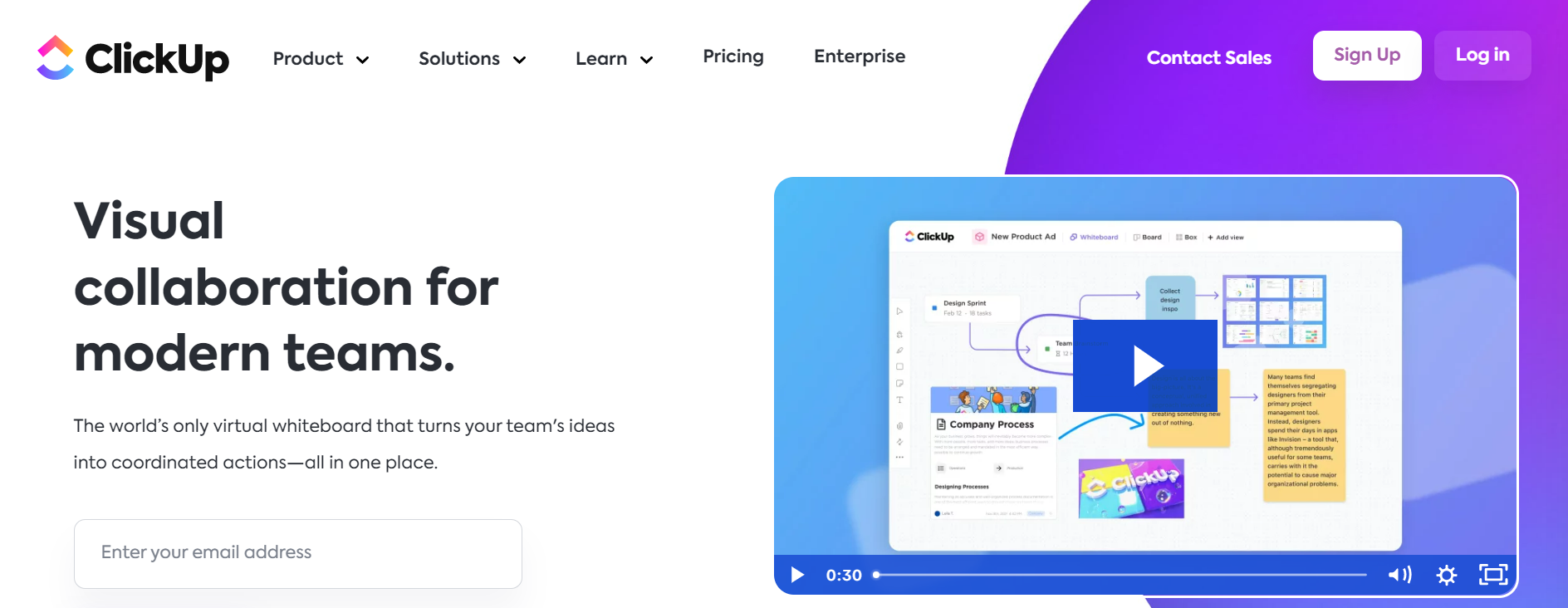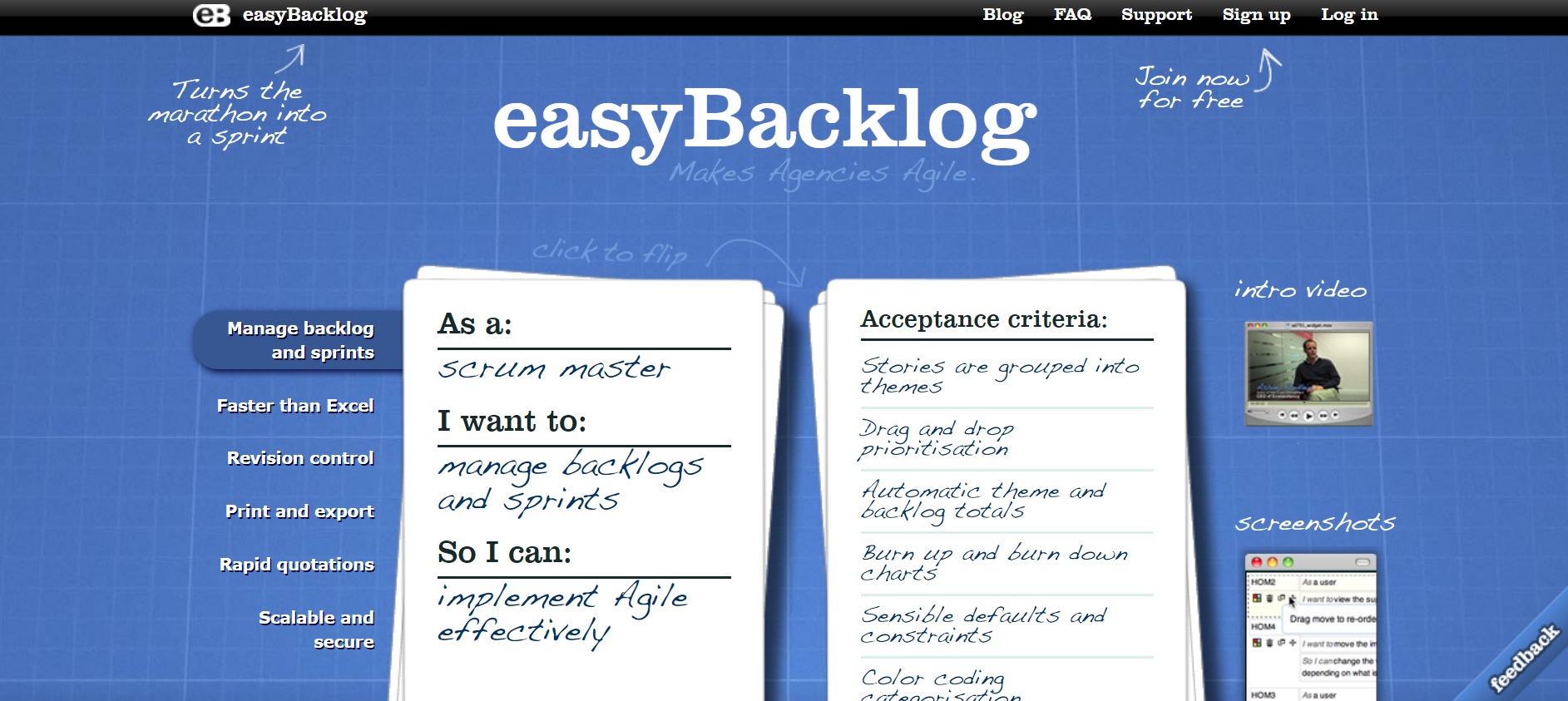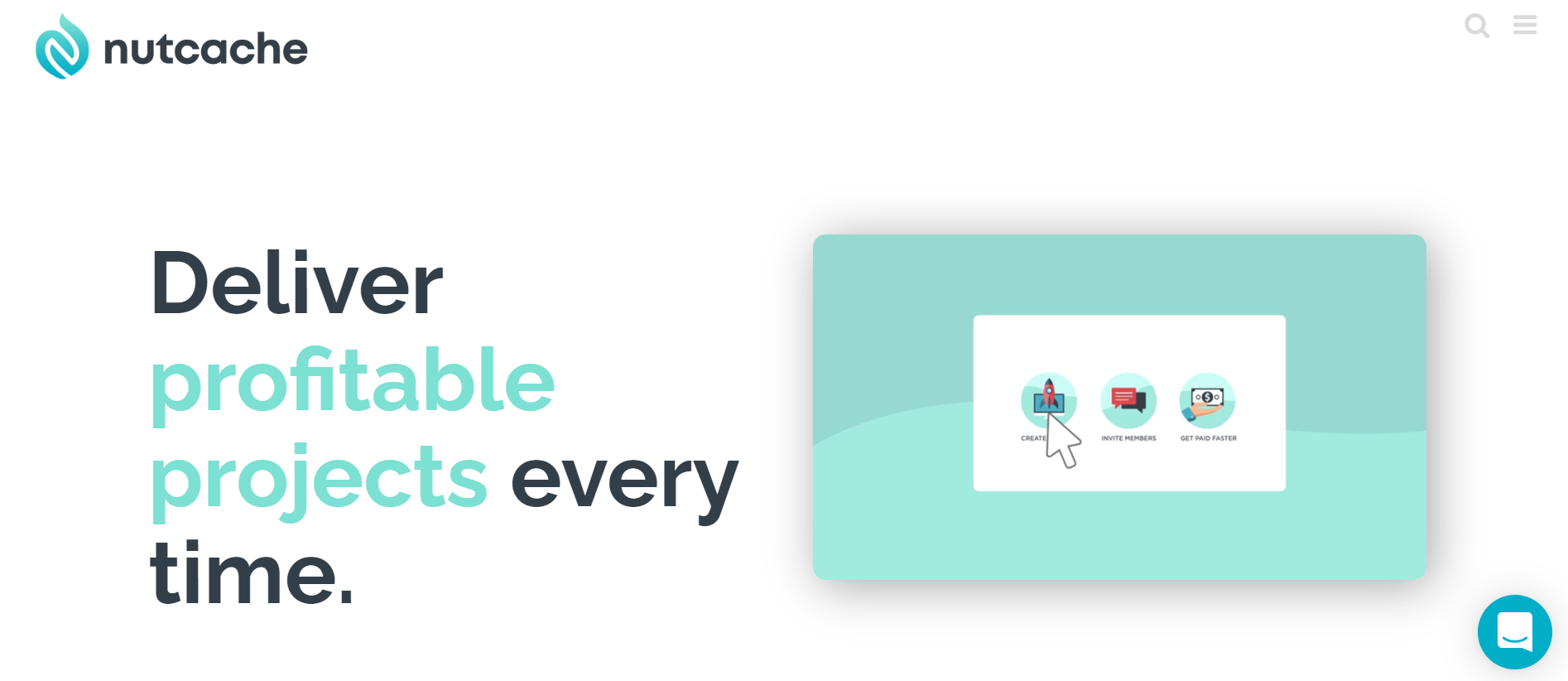- What is Scrum Project Management - Bottom Line Up Front
- What are Scrum and Agile Project Management?
- Elements of Scrum Project Management
- Scrum Project Management Pros and Cons
- Using Scrum Project Management Software
- 3 Leading Scrum Project Management Tools
- 3 Agile Project Management Alternatives to Scrum
- FAQs about What is Scrum Project Management
Last Updated on July 19, 2023 by Ewen Finser
There are all sorts of ways to manage a project. And while some projects spend a lot of time in the planning and development phases, others move quite a bit faster. When it comes to moving projects forward and adapting as you go along, agile project management reigns supreme, and Scrum is one of the most popular agile approaches.
Behind Scrum and an agile approach is a belief that mistakes and change are unavoidable, and the quicker you can get through the development stage, the quicker you can get feedback, revise and try again.
What is Scrum Project Management – Bottom Line Up Front
Scrum is a type of project management approach that utilizes short work cycles, called “sprints,” to rapidly produce, test and revise products. A Scrum Master is in charge of a small team of workers, and everyone meets daily to talk about what’s being worked on that day and problems that need to be cleared so work can progress as fast as possible.
What are Scrum and Agile Project Management?
Scrum is a type of agile project management that relies on short work cycles — referred to as “sprints” — so that products can be developed and tested fast. For our purposes, the term agile refers to a type of project management that uses short work cycles to build products. This approach means that production can be rapid and products are constantly being revised.
Usually, only a small team works on the project at hand, with a Scrum Master leading the team. The main responsibility of the Scrum Master is to get rid of any obstacles that stand in the way of work being completed. Every day, the team will meet to talk about the day’s tasks and roadblocks that need to be cleared out of the way.
The Scrum Master is also responsible for ensuring the correct processes are followed. However, the Scrum Master is not a dictator – on the contrary, one of the reasons why Scrum works so well is because of the collaborative environment where everyone feels important and like they have a voice.
The Pillars of Scrum Project Management
Scrum provides a structure so that teams can uphold the pillars of this type of project management methodology:
- Prioritize efficient project planning
- Execute the project in a collaborative way
- Continuously improve
To make sure the entire team stays on track and can work without distractions, it’s important to create the right Scrum environment, which includes standardized best practices and processes. The Scrum environment also includes the people and platforms used for the project.
Who Is Scrum For?
Scrum was initially designed to be used in IT and software environments. However, today, it’s also used for manufacturing, marketing, and product development. The Scrum approach has also been adopted by major companies like Adobe, Intel, and Netflix, according to The Knowledge Academy. Businesses like these use Scrum to:
- Experiment with new features that may or may not be adopted long-term but that currently meet customer demands.
- Improve and repair software defects on products that have already been rolled out to the public.
- Improve employee morale by amping up productivity through Scrum sprints.
Overall, companies use Scrum to innovate at a fast pace and deliver top-notch customer value.
Elements of Scrum Project Management
For the most part, Scrum project management always follows a specific framework. The elements of Scrum are as follows:
- Product Backlog: You’ll hear about the “backlog” a lot when it comes to Scrum. The product backlog is a list of tasks that need to be taken care of for the project.
- Sprint Planning Session: Once the product backlog is created, the Scrum team will hold a sprint planning session. The tasks required to complete everything on the product backlog will be broken down into smaller tasks that are easier to tackle.
- Sprint Backlog and Planning: Information from the sprint planning session is turned into a sprint backlog. The team will decide how to implement the sprints and how long each one will take. Usually, sprints last about two weeks, but they may be as long as four weeks.
- Daily Standup: This is the daily meeting that the Scrum team will attend. During this meeting, each team member will share their latest updates. The goal is for the Scrum Master to figure out how much progress is being made. Also, anything that needs troubleshooting will be brought up during this meeting.
- Review: At the end of each sprint, the product owner (and usually the stakeholders) will conduct a review. This is also when customer feedback is considered so that those suggestions are part of revisions.
Scrum Project Management Pros and Cons
There are a lot of reasons why Scrum project management is used today. However, this is a complex and sometimes risky approach to project management, and it’s not without its faults. Let’s go over the pros and cons of Scrum project management.
Scrum Pros
- Changes are easy to apply thanks to the fast pace of short sprints
- Each member of the team is valued for their effort
- Feedback is encouraged, which means customers and stakeholders get their opinions heard
- Ideal approach for development projects that have to move fast
- Large projects are broken down into sprints that are much easier to manage
- Regular meetings ensure the team always knows what’s going on
- Teams are able to meet project deliverables quickly
- Time and money are both used effectively
Scrum Cons
- Daily meetings can get frustrating, especially for workers who feel they’re behind
- Experienced Scrum users are necessary for setting up an effective framework
- Having a definite end date on each sprint can cause anxiety
- It’s difficult for large teams to adopt a Scrum system
- Quality is difficult to implement until the product goes through the testing phase
- The risk of failure is high if team members aren’t committed to the process or able to work cooperatively
- Team members who leave mid-project can have a major negative effect on the project
Using Scrum Project Management Software
Scrum teams often use a digital whiteboard to keep track of all of the elements of a project. There are a lot of digital tools out there to help you with Scrum management. Let’s go over some of the top ones to see if they’re a good match for your team. First, though, let’s discuss the Scrum features you may want in the tool you choose.
Scrum Software Features To Look For
While not every Scrum tool will tick every single box possible, there are a number of features to consider. Figure out what’s important for your team, then make sure that your tool of choice has what you need.
Note: some of these features may have different names based on the software you’re looking into.
- Burndowns and Burnups: Create a burndown chart to see how well the project is progressing based on the target; create a burnup chart to see what work needs to be completed.
- Cumulative Flow: Visualize bottlenecks by tracking where different tasks are.
- Dependencies: Block certain tasks from being started until other tasks are completed.
- Documents: Create documents within the software and collaborate via features like commenting and task lists.
- Recurring Tasks: Create a task once and then set it to recur on a schedule.
- Sprints: Create sprints, set sprint dates, designate priority levels and assign sprints to team members.
- Task Status: Create stages that tasks can be assigned to so that you know the status of every task being worked on.
- Time Estimates: Set time estimates for tasks so that everyone knows what’s expected of them.
- To-Do Lists: Create to-do lists that let you format, color-code and link entries with assignees and/or tasks.
- Velocity: View a graph with the average velocity of task completion; this lets you anticipate the task completion rate.
- Views: Switch views from Scrum to kanban board to Gantt chart, etc.
Lastly, if you’re already using other project management tools, it’ll be a big help to use Scrum software that integrates with the services you already rely on.
3 Leading Scrum Project Management Tools
There are a lot of Scrum tools to check into, but many of them have major drawbacks that we don’t think you’ll be able to get past – for example, a few we checked into didn’t let you set due dates. How could that be helpful?!
These three come in at different price points (hello, free!) and have the features you’ll want, whether you’re happy with a short list or need every single option at your fingertips.
1. ClickUp
ClickUp is one of the better-known project management tools out there, and along with Scrum boards, you can also create Gantt charts. Also, ClickUp offers real-time collaboration, so if your team needs to communicate quite a bit, they won’t have to turn to another tool just to keep in touch. Moreover, ClickUp lets you create unlimited tasks, which is a definite must for those complex projects.
Personally, I’ve used ClickUp for project management, and it certainly has a ton of features – probably more than you’ll ever use. And while the learning curve is a bit…curvy…once you get the hang of ClickUp, it’s not overwhelming to use on a daily basis. Plus, all of those features mean you can really make it work for you, Scrum boards and otherwise.
2. EasyBacklog
If you need a relatively basic – and free – Scrum management tool, consider EasyBacklog. Features include creating different versions of sprint backlogs to compare them, creating budgets and cost estimates, and building burndown/burnup charts.
There is a major drawback of EasyBacklog, though: There isn’t a mobile app that you can use, so if you need to stay connected on the go a lot, you’ll be out of luck unless you can always set up your computer.
Still, if you have minor Scrum needs – maybe you have an extra-small team and a minor project to complete – or you’re trying to figure out if Scrum is even the right approach, you can’t get more convenient than a total freebie of a tool. You can always upgrade to a more powerful (and paid) tool later on if you decide this is the right path for your company.
3. Nutcache
Nutcache software allows you to plan, organize and analyze Scrum tasks, and it works whether your needs are minimal or complex. Define a sprint’s duration and goal, then measure progress to make sure everything’s on track. The biggest flaw with Nutcache is that it may not have all of the reporting features you need – for example, you can process financial reports (but if you have another tool that you use for resource management, that won’t matter).
3 Agile Project Management Alternatives to Scrum
While Scrum and kanban are two of the most well-known and popular agile project management methodologies today, they’re not the only ones out there. Let’s go over three alternatives that you may find work better for the project at hand.
Crystal
The idea behind Crystal is to get rid of as much communication and documentation as possible, and in line with that, in-person communication is favored. Instead of one specific methodology, Crystal has a color-based framework, and the color you choose will be based on the team and the risk level of the project. Crystal is a useful methodology if the development team has easy access to expert users so they can always be gathering feedback.
DSDM
DSDM, which stands for Dynamic Systems Development Method, begins with a Foundations phase, during which just enough design work is handled up-front. From there, iterations develop the design further. DSDM may be a good alternative to Scrum when there’s a big business change taking place, especially if the team is comprised of a lot of different roles and skill sets.
XP
XP, which stands for eXtreme Programming (yes, with the capital “X”), is most popular with software engineering teams. The main goal of XP is to lower how much changes cost. Since change is seen as an inevitable part of a project, XP strives to make it easy to adapt to those changes.
Like Scrum, XP is best for small teams of 12 or under. And like Crystal, XP works best if the team has a lot of customer participation. This is also an approach used specifically in software engineering, so it’s not a fit for a broad range of industries.
FAQs about What is Scrum Project Management
Question: Where did the name “Scrum” come from?
Answer: The Scrum methodology is named after a rugby term. In rugby, a “scrum” is a formation of players. Because the term implies teamwork, it was adopted for the agile project management approach.
Question: What’s the difference between kanban and Scrum?
Answer: At first, kanban boards and Scrum boards can look pretty much the same. However, there’s a big difference between the two:
• A Scrum board tracks a single sprint. It’s owned by one Scrum team.
• A kanban board tracks all of the teams that are working on a project and likely all of the tasks being worked on, too.
Question: What is the difference between Scrum and agile?
Answer: Agile is a project management philosophy, while Scrum is a type of agile methodology. Scrum is always agile, but agile is not always Scrum.








